You
are receiving this because your address is subscribed at: www.jaunay.com/newsletter.html |
|
 |
| No: 69 |
November 2011
|
|
News November seminars 13: Coming to grips with FamilySearch, WEA Centre Adelaide, 10:00am to 1:00pm December seminars There is no program in December. See the seminar program for more details and bookings. Adelaide Proformat will be closed 23 Dec 2001 to 22 Jan 2012 Discount booking fees for the 13th Congress close 30 November. Pedigree charts and family sheets The previous newsletter raised a number of questions from readers about family trees. Essentially many of the web sites mentioned are not about family trees per se but rather about pedigree charts and family sheets. One thing that will quickly become evident from much of the material published on the web is that it lacks credibility. Most posters do not cite their sources and if you are tempted to take on board any of the material you find, you would be well advised to read and digest the following principals. The basic principles of research • Never assume anything.There are two tools that every researcher should use to record their findings. |
In
this issue: |
|
Graham Jaunay Services
|
| There are a number of other instruments that will ensure your work is as professional and scientific as possible. Family history creates a large amount of data and the management of it is important. Some of the other instruments can be viewed at Adelaide Proformat's website. (see next link) Using Pedigree Charts The Pedigree Chart is an essential tool in family history research: You can buy blank charts.When working on paper, use pencil until you are certain the entry is correct and then enter in pen. If you are using a computer program consider entering unconfirmed material in a different colour. 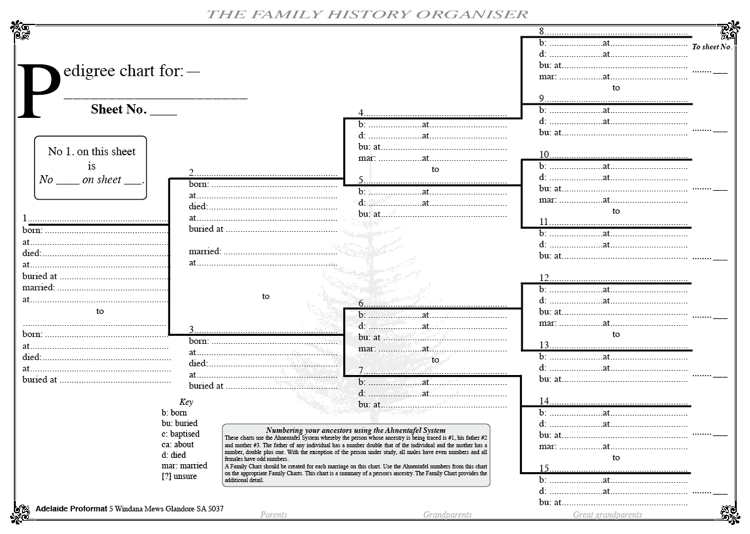 On pedigree charts, males are allocated even numbers and females the odd numbers and this system is called the Stradonitz [or Sosa-Stradonitz or Ahnentafel ahnen tafel = ancestor table] System and dates from 1676 when it was first used by Spanish genealogist, Jerome de Sosa. De Sosa was a 17th century Franciscan friar and a genealogist who developed a genealogical numbering system of ancestors. The scheme remained virtually unknown until popularised by Stephan von Stradonitz in his Ahnentafel-atlas that detailed the families of the sovereigns of Europe and their wives and was published in 1898 to 1904. The following image is from p9 of de Sosa's book on the genealogy of Don Pedro Álvarez de Toledo, 2nd Marquis of Villafranca 1484–1553, outlining not only how the pedigree chart should be arranged with 5 generations to the page, but also demonstrating through the use of the letters of the alphabet how to extend the chart on to further generations. 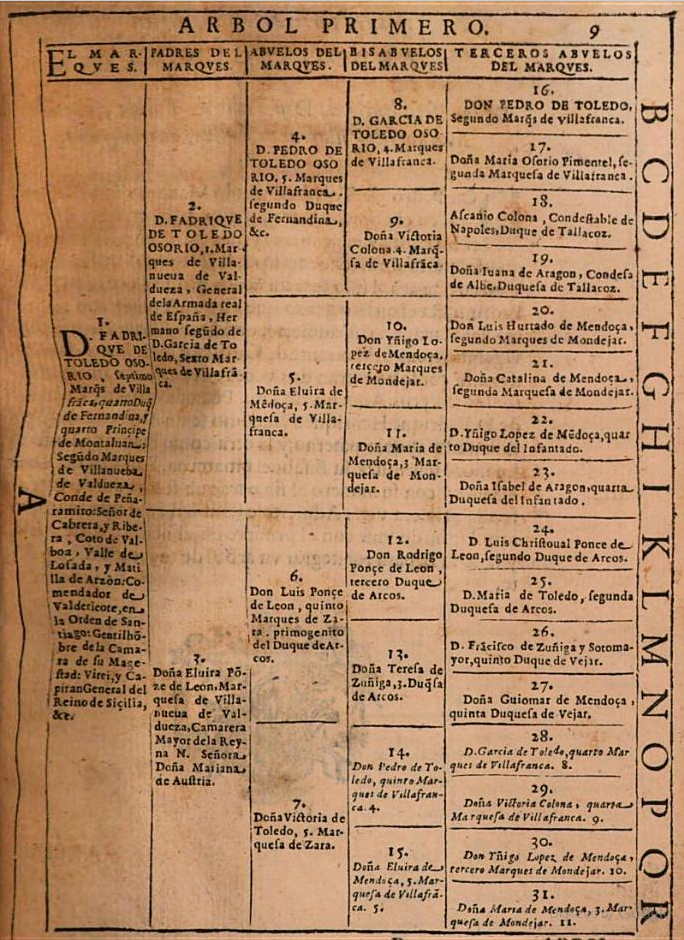 This extremely easy and effective method of numbering your ancestors is to assign the person whose pedigree it is the number 1. Their father is No 2, their mother No 3, their paternal grandfather No 4, etc. In this system, a person's father's number is always twice the person's number and his or her mother's number is twice plus one. That means you can easily assign a number to any direct ancestor. If the person you are looking at is #7 then you know their father will be #14 and their mother #15. Effectively the chart summarises you ancestry thus: 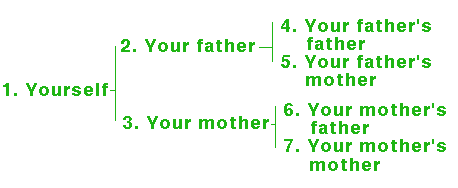 The pedigree chart format promoted on the Adelaide Proformat web site enables one to extend beyond the first sheet much the same way as de Sosa advocated. Using the features on each pedigree chart, they can be tiled. The example shows that the person at position 8 on sheet 1 becomes the person at position 1 on sheet 2. Of course using a computer family history program alleviates all these considerations. 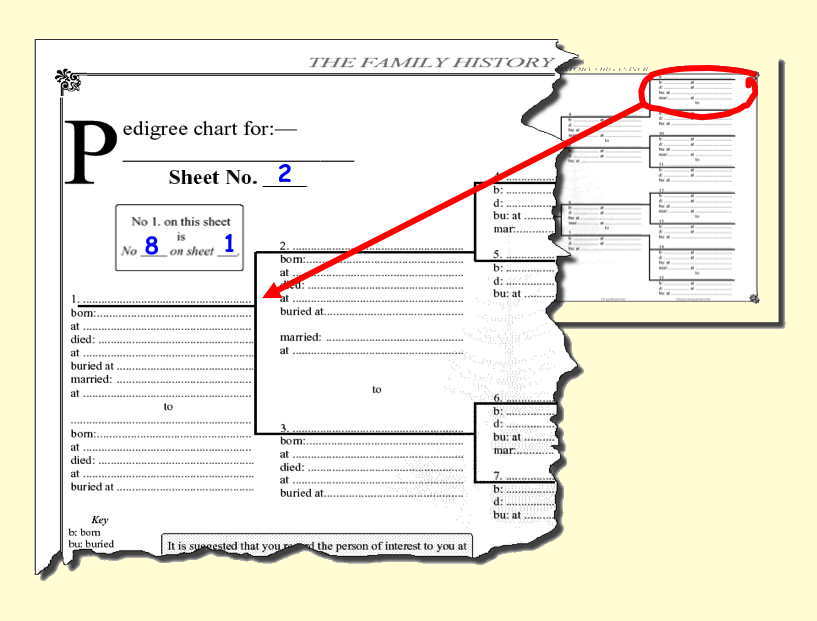 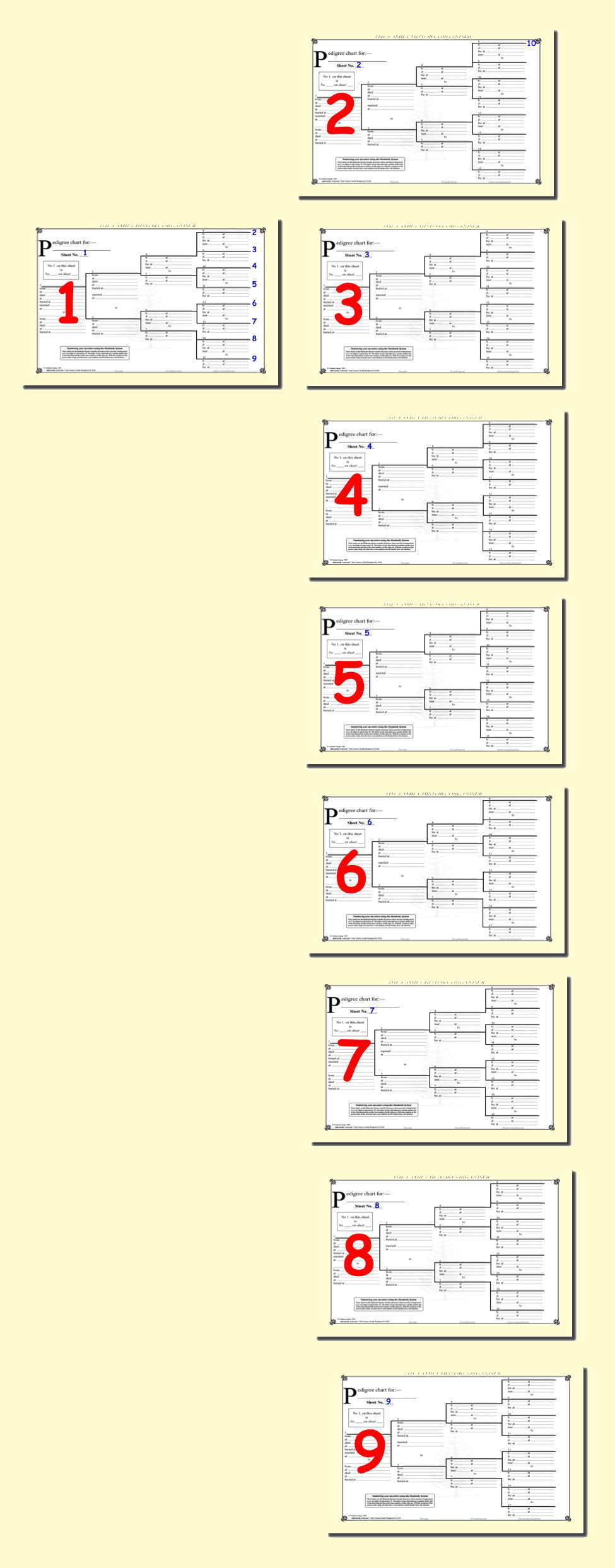 We cannot stress too much the appropriate use of some standard conventions to assist readers of charts. Family historians need to be constantly aware that the work they produce is not necessarily going to be read by fellow devotees and they should design their work for general public consumption. Unfortunately the web is awash with material whose content is not readily clear to the amateur (or too many professionals for that matter). If you choose not to use the usual conventions that are not only widely accepted but are designed to be self explanatory, then you should provide your reader with guidelines. Use the following conventions for completing charts to help avoid ambiguity: Names of people • Print clearly.Dates • Print clearly.Places • Print the place, being as specific as possible using Chapman and/or ISO Codes thus… Ashford SA and Berwick-on-Tweed NBL There is a comprehensive listing of ISO and Chapman codes on the Adelaide Proformat web site: • Australia • Use the address as at the time of the event. Once you have completed your Pedigree Chart the gaps are indicating your research program. The nearer the gap is to person 1, the higher should be its priority! Gaps in your recent family history can be easily and cheaply plugged!To accommodate the constraints of paper, Pedigree Charts can be tiled by using the embedded links. Computer generated charts will do this automatically if you print them out. Two things to remember: 1. A pedigree chart is just that – it outlines a person’s ancestry.Using Family Sheets The Family Sheet is the other essential tool in family history research. It complements the pedigree chart in that it details the material summarised in a pedigree chart in more detail by developing the family members and their associated genealogy. In spite of this, family sheets are not family histories. You should fill out a Family Sheet for every married couple in your pedigree. Note: If you are a parent, you will put yourself on two Family Sheets—once as a child, along with your parents, brothers and sisters—and, once as a parent with your spouse and children. If you have married more than once, you will appear on that sheet too! • Family Sheets allow you to provide more detail than a Pedigree Chart and have provision for the inclusion of your ancestors’ siblings. 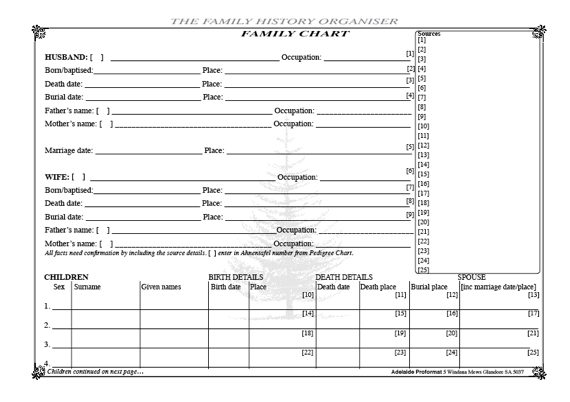 |
|
| To
unsubscribe send a blank email via the following link using the same
address you subscribed to: newsletter-leave@jaunay.com |